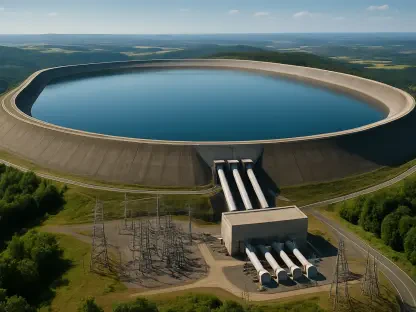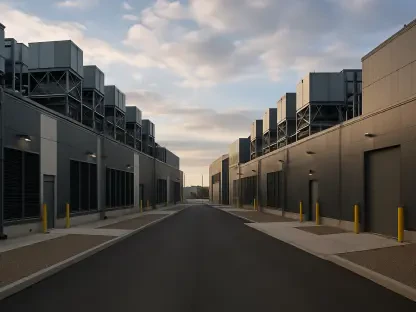In the realm of renewable energy, innovative solutions consistently emerge to address the world’s growing environmental and energy challenges. Among such innovations is the integration of solar panels into railway tracks, proposed by Swiss startup Sun-Ways, which has introduced a pioneering photovoltaic railway system. This groundbreaking project aims to transform conventional railway infrastructure into a dual-purpose entity capable of transporting goods and passengers while simultaneously generating renewable energy. This bold initiative not only holds promise for sustainable energy solutions but also represents a trailblazing approach in blending technology with ecological responsibility. The anticipation of this concept lies in its potential to reduce land acquisition for solar farms and create a sustainable loop of energy utilization in the transportation sector.
A New Era of Solar Technology Integration
The Concept Behind the Photovoltaic System
At the heart of this solar innovation is the idea to use existing railway tracks for solar panel installation, eliminating the need for additional land. The photovoltaic system employs a patented attachment mechanism that allows for the seamless integration of solar panels onto train tracks. This approach taps into an existing infrastructure, making it not only efficient but accessible for widespread implementation. The panels are designed to be removable, a crucial feature that preserves the integrity of maintenance and ensures unobstructed rail operations. With this feature, the panels can be detached for essential inspections, solving potential issues related to conventional solar systems in transportation contexts.
Sun-Ways has embarked on a three-year pilot phase to test the system’s feasibility on various fronts, including performance, safety, and durability. The pilot’s projections estimate an annual energy production of around 16 megawatt-hours, which suffices the power needs of several Swiss households. While modest at this stage, the trial serves as an important milestone in assessing scalability and adaptability. Beyond its capacity to generate electricity, the innovation exemplifies a novel application of solar technology in previously untapped areas while maintaining operational continuity in railway systems.
Engineering and Environmental Considerations
The integration of solar panels into railway tracks involves complex engineering and environmental considerations. This technology requires a meticulous evaluation of how solar panels can withstand the mechanical stresses and vibrations typical in railway environments. Factors such as panel durability, security against theft, and resilience to harsh weather conditions become paramount in this assessment. Engineers work to ensure the panels do not compromise the structural integrity or safety standards of existing railway systems. Additionally, environmental impact studies examine the potential benefits and challenges posed by this shift, such as effects on local ecosystems and contributions to reducing carbon footprints.
Moreover, the panels are designed to be efficient in harnessing sunlight, optimized for maximal energy capture irrespective of the train’s movement. The coordination between solar systems and rail operations requires precise timing to avoid any disruptions in transport activities. Compatibility with different railway gauges and contamination prevention strategies are also considered, underscoring the thorough deliberation driving this innovation. The system’s success would hinge on overcoming these challenges, setting new precedences for engineering solutions that prioritize both technological efficacy and environmental stewardship.
Pioneering Global Adoption
Testing the Waters on an International Scale
Switzerland’s pioneering efforts in solar railway systems present a promising avenue for global energy solutions. Sun-Ways’ ambition extends beyond national borders, envisioning implementations in diverse landscapes and infrastructures worldwide. Countries such as France, Spain, South Korea, China, and the United States are potential candidates for adopting this novel technology. This anticipates a future where railway systems worldwide may play a crucial role in both transportation and energy generation. Adapting the technology to varied regional contexts involves tailoring it to specific environmental conditions and regulatory frameworks, requiring collaboration with local governments and industry stakeholders.
The global ambition is spurred by forecasts that recognize the potential for railway photovoltaic systems to contribute significantly to renewable energy production. The sustainable transformation involving these systems could bolster the international climate goals, decreasing reliance on fossil fuels and fostering green energy solutions. The broad adaptation beyond Swiss borders would illustrate the universal applicability of the technology, factoring in geographic and infrastructural diversity. This global vision postulates renewable energy as a cornerstone in the 21st-century’s quest to combat climate change.
Expanding on Energy Utilization
In practical terms, one of the intriguing prospects of railway-integrated solar panels is their capacity to create self-sustaining cycles of energy utilization. The electricity produced could eventually be directly used to power trains, representing a shift towards autonomous railway systems. This integration fosters closed-loop processes where energy is generated and consumed within railway operations, drastically cutting emissions and operational costs. The success of this solar system could revolutionize the transportation sector and set benchmarks for similar cross-sectional innovations in urban infrastructure.
Building on potential successes, future expansions may involve complementing solar systems with other renewable technologies. For instance, integrating wind or hydropower systems alongside solar panels could amplify energy efficiency and sustainability goals. As research continues, further advancements are anticipated in optimizing solar system designs for enhanced energy yield, cost-effectiveness, and operational reliability. The leap towards multifunctional infrastructure illustrates a transformation where technologies are intertwined to generate ecological benefits, fostering collaboration between industries to pursue sustainable futures.
Looking Ahead: Implications for a Sustainable Future
At the core of this solar innovation is a groundbreaking concept: using current railway tracks for solar panel placement, thereby bypassing the necessity for extra land. The photovoltaic arrangement utilizes a patented attachment system, allowing for seamless solar panel integration on train tracks. This method capitalizes on current infrastructure, enhancing efficiency and facilitating widespread use. A key feature is the panels’ removability, preserving the track’s maintenance integrity and ensuring seamless rail operations. This detachable design resolves potential issues seen in traditional solar systems used in transportation, allowing for necessary inspections and repairs.
Sun-Ways has launched a three-year trial phase to test the system’s practicality, examining factors such as output, safety, and resilience. The trial forecasts an annual energy yield of approximately 16 megawatt-hours, enough to power multiple Swiss homes. Although modest, this trial is a pivotal step toward evaluating scalability and flexibility. Beyond energy generation, this innovation represents a novel application of solar tech in previously untapped areas, all while maintaining railway operational efficiency.









